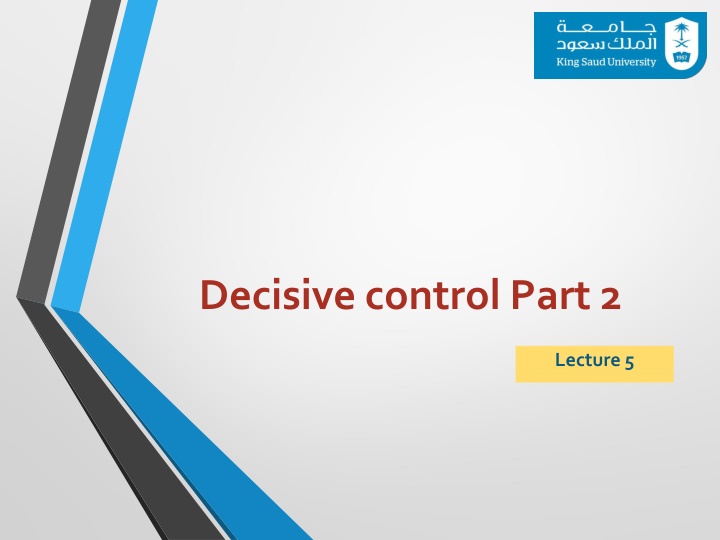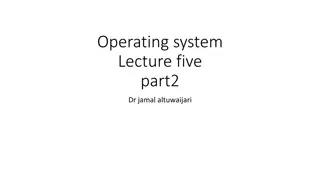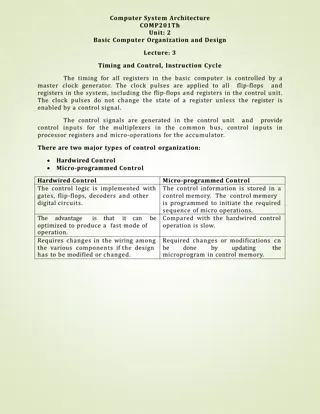
Mastering Increment and Decrement Operators for Efficient Programming
Dive deep into the world of increment and decrement operators in programming. Understand how to use preincrement and postincrement operators effectively to manipulate variables in expressions. Explore the concept of switch multiple-selection structures and learn about formulating algorithms using counter-controlled repetition.
Download Presentation

Please find below an Image/Link to download the presentation.
The content on the website is provided AS IS for your information and personal use only. It may not be sold, licensed, or shared on other websites without obtaining consent from the author. If you encounter any issues during the download, it is possible that the publisher has removed the file from their server.
You are allowed to download the files provided on this website for personal or commercial use, subject to the condition that they are used lawfully. All files are the property of their respective owners.
The content on the website is provided AS IS for your information and personal use only. It may not be sold, licensed, or shared on other websites without obtaining consent from the author.
E N D
Presentation Transcript
Decisive control Part 2 Lecture 5
Increment and Decrement Operators Increment operator (++) - can be used instead of c += 1 Decrement operator (--) - can be used instead of c -= 1 Preincrement When the operator is used before the variable (++c or c) Variable is changed, then the expression it is in is evaluated. Posincrement When the operator is used after the variable (c++ or c- -) Expression the variable is in executes, then the variable is changed.
Increment and Decrement Operators Increment operator (++) Increment variable by one c++ Same as c += 1 Decrement operator (--) similar Decrement variable by one c--
Increment and Decrement Operators Preincrement Variable changed before used in expression Operator before variable (++c or --c) Postincrement Incremented changed after expression Operator after variable (c++, c--)
switch Multiple-Selection Structure Test variable for multiple values Series of case labels and optional default case switch ( variable ) { case value1: // taken if variable == value1 statements break; // necessary to exit switch case value2: case value3: // taken if variable == value2 or == value3 statements break; default: // taken if variable matches no other cases statements break; }
Formulating Algorithms (Counter-Controlled Repetition) Counter-controlled repetition Loop repeated until counter reaches certain value Definite repetition Number of repetitions known Example A class of ten students took a quiz. The grades (integers in the range 0 to 100) for this quiz are available to you. Determine the class average on the quiz.
fig02_07.cpp (1 of 2) // Fig. 2.7: fig02_07.cpp // Class average program with counter-controlled repetition. #include <iostream> using namespace std; // function main begins program execution int main() { int total; // sum of grades input by user int gradeCounter; // number of grade to be entered next int grade; // grade value int average; // average of grades // initialization phase total = 0; // initialize total gradeCounter = 1; // initialize loop counter
// processing phase while ( gradeCounter <= 10 ) { // loop 10 times cout << "Enter grade: "; // prompt for input cin >> grade; // read grade from user total = total + grade; // add grade to total gradeCounter = gradeCounter + 1; // increment counter } // termination phase average = total / 10; // integer division cout.setf (ios::fixed) cout.setf(ios::showpoint); cout.precision(2); // display result cout << "Class average is " << average << endl; return 0; // indicate program ended successfully } // end function main fig02_07.cpp (2 of 2) fig02_07.cpp output (1 of 1) The counter gets incremented each time the loop executes. Eventually, the counter causes the loop to end. Enter grade: 98 Enter grade: 76 Enter grade: 71 Enter grade: 87 Enter grade: 83 Enter grade: 90 Enter grade: 57
Formulating Algorithms (Sentinel-Controlled Repetition) Suppose problem becomes: Develop a class-averaging program that will process an arbitrary number of grades each time the program is run Unknown number of students How will program know when to end? Sentinel value Indicates end of data entry Loop ends when sentinel input Sentinel chosen so it cannot be confused with regular input -1 in this case
Formulating Algorithms (Sentinel-Controlled Repetition) Many programs have three phases Initialization Initializes the program variables Processing Input data, adjusts program variables Termination Calculate and print the final results Helps break up programs for top-down refinement
fig02_09.cpp (1 of 3) // Fig. 2.9: fig02_09.cpp // Class average program with sentinel-controlled repetition. #include <iostream> #include <iomanip> // parameterized stream manipulators using namespace std; // sets numeric output precision // function main begins program execution int main() { int total; // sum of grades int gradeCounter; // number of grades entered int grade; // grade value double average; // number with decimal point for average // initialization phase total = 0; // initialize total gradeCounter = 0; // initialize loop counter Data type double used to represent decimal numbers.
26 27 // processing phase 28 // get first grade from user 29 cout << "Enter grade, -1 to end: "; // prompt for input 30 cin >> grade; // read grade from user 31 32 // loop until sentinel value read from user 33 while ( grade != -1 ) { 34 total = total + grade; // add grade to total 35 gradeCounter = gradeCounter + 1; // increment counter 36 37 cout << "Enter grade, -1 to end: "; // prompt for input 38 cin >> grade; // read next grade 39 40 } // end while 41 42 // termination phase 43 // if user entered at least one grade ... 44 if ( gradeCounter != 0 ) { 45 // calculate average of all grades entered 47 average = static_cast< double >( total ) / gradeCounter; 48 fig02_09.cpp (2 of 3) static_cast<double>() treats total as a double temporarily (casting). Required because dividing two integers truncates the remainder. gradeCounter is an int, but it gets promoted to double.
cout.setf (ios::fixed); cout.setf(ios::showpoint); cout.precision(2); cout << "Class average is " <<average << endl; 52 53 } // end if part of if/else 54 55 else // if no grades were entered, output appropriate message 56 cout << "No grades were entered" << endl; 57 58 return 0; // indicate program ended successfully 59 60 } // end function main Enter grade, -1 to end: 88 Enter grade, -1 to end: 70 Enter grade, -1 to end: 64 Enter grade, -1 to end: 83 Enter grade, -1 to end: 89 Enter grade, -1 to end: -1 Class average is 82.50 fig02_09.cpp (3 of 3) 50 fig02_09.cpp output (1 of 1) setprecision(2)prints two digits past decimal point (rounded to fit precision). in fixed point format (not scientific notation). Also, forces trailing zeros and decimal point to print. fixed forces output to print Enter grade, -1 to end: 75 Enter grade, -1 to end: 94 Enter grade, -1 to end: 97 Programs that use this must include <iomanip> Include <iostream>
Nested Control Structures Problem statement A college has a list of test results (1 = pass, 2 = fail) for 10 students. Write a program that analyzes the results. If more than 8 students pass, print "Raise Tuition". Notice that Program processes 10 results Fixed number, use counter-controlled loop Two counters can be used One counts number that passed Another counts number that fail Each test result is 1 or 2 If not 1, assume 2
2 // Analysis of examination results. 3 #include <iostream> 4 using namespace std; 5 // function main begins program execution 10 int main() 11 { 12 // initialize variables in declarations 13 int passes = 0; // number of passes 14 int failures = 0; // number of failures 15 int studentCounter = 1; // student counter 16 int result; // one exam result 17 18 // process 10 students using counter-controlled loop 19 while ( studentCounter <= 10 ) { 20 21 // prompt user for input and obtain value from user 22 cout << "Enter result (1 = pass, 2 = fail): "; 23 cin >> result; 24 fig02_11.cpp (1 of 2)
passes = passes + 1; 27 28 29 30 31 32 33 34 35 } // end while 36 37 // termination phase; display number of passes and failures 38 cout << "Passed " << passes << endl; 39 cout << "Failed " << failures << endl; 40 41 // if more than eight students passed, print "raise tuition" 42 if ( passes > 8 ) 43 cout << "Raise tuition " << endl; 44 45 return 0; // successful termination 46 47 } // end function main fig02_11.cpp (2 of 2) else // if result not 1, increment failures failures = failures + 1; // increment studentCounter so loop eventually terminates studentCounter = studentCounter + 1;
Enter result (1 = pass, 2 = fail): 2 Enter result (1 = pass, 2 = fail): 1 Enter result (1 = pass, 2 = fail): 1 Enter result (1 = pass, 2 = fail): 1 Enter result (1 = pass, 2 = fail): 2 Enter result (1 = pass, 2 = fail): 1 Enter result (1 = pass, 2 = fail): 1 Enter result (1 = pass, 2 = fail): 2 Passed 6 Failed 4 fig02_11.cpp output (1 of 1) Enter result (1 = pass, 2 = fail): 1 Enter result (1 = pass, 2 = fail): 1 Enter result (1 = pass, 2 = fail): 1 Enter result (1 = pass, 2 = fail): 1 Enter result (1 = pass, 2 = fail): 2 Enter result (1 = pass, 2 = fail): 1 Enter result (1 = pass, 2 = fail): 1 Enter result (1 = pass, 2 = fail): 1 Enter result (1 = pass, 2 = fail): 1 Enter result (1 = pass, 2 = fail): 1 Passed 9 Failed 1 Raise tuition
Assignment Operators Assignment expression abbreviations Addition assignment operator c = c + 3; abbreviated to c += 3; Statements of the form variable = variable operator expression; can be rewritten as variable operator= expression; Other assignment operators d -= 4 (d = d - 4) e *= 5 (e = e * 5) f /= 3 (f = f / 3) g %= 9 (g = g % 9)
Increment and Decrement Operators Increment operator (++) - can be used instead of c += 1 Decrement operator (--) - can be used instead of c -= 1 Preincrement When the operator is used before the variable (++c or c) Variable is changed, then the expression it is in is evaluated. Posincrement When the operator is used after the variable (c++ or c- -) Expression the variable is in executes, then the variable is changed.
Increment and Decrement Operators Increment operator (++) Increment variable by one c++ Same as c += 1 Decrement operator (--) similar Decrement variable by one c--
Increment and Decrement Operators Preincrement Variable changed before used in expression Operator before variable (++c or --c) Postincrement Incremented changed after expression Operator after variable (c++, c--)
Essentials of Counter-Controlled Repetition Counter-controlled repetition requires Name of control variable/loop counter Initial value of control variable Condition to test for final value Increment/decrement to modify control variable when looping
controlled repetition. 2 3 #include <iostream> 4 using namespace std; 5 // function main begins program execution 9 int main() 10 { 11 int counter = 1; // initialization 12 13 while ( counter <= 10 ) { // repetition condition 14 cout << counter << endl; // display counter 15 ++counter; // increment 16 17 } // end while 18 19 return 0; // indicate successful termination 20 21 } // end function main fig02_16.cpp (1 of 1)
for Repetition Structure General format when using for loops for ( initialization; LoopContinuationTest; increment ) statement Example for( int counter = 1; counter <= 10; counter++ ) cout << counter << endl; Prints integers from one to ten No semicolon after last statement
1 // Fig. 2.17: fig02_17.cpp 2 // Counter-controlled repetition with the for structure. 3 #include <iostream> 4 using namespace std; 5 // function main begins program execution 9 int main() 10 { 11 // Initialization, repetition condition and incrementing 12 // are all included in the for structure header. 13 14 for ( int counter = 1; counter <= 10; counter++ ) 15 cout << counter << endl; 16 17 return 0; // indicate successful termination 18 19 } // end function main fig02_17.cpp (1 of 1)
for Repetition Structure for loops can usually be rewritten as while loops initialization; while ( loopContinuationTest){ statement increment; } Initialization and increment For multiple variables, use comma-separated lists for (int i = 0, j = 0; j + i <= 10; j++, i++) cout << j + i << endl;
1 // Fig. 2.20: fig02_20.cpp 2 // Summation with for. 3 #include <iostream> 4 using namespace std; // function main begins program execution 9 int main() 10 { 11 int sum = 0; // initialize sum 12 13 // sum even integers from 2 through 100 14 for ( int number = 2; number <= 100; number += 2 ) 15 sum += number; // add number to sum 16 17 cout << "Sum is " << sum << endl; // output sum 18 return 0; // successful termination 19 20 } // end function main Sum is 2550 fig02_20.cpp (1 of 1) fig02_20.cpp output (1 of 1)
Examples Using the for Structure Program to calculate compound interest A person invests $1000.00 in a savings account yielding 5 percent interest. Assuming that all interest is left on deposit in the account, calculate and print the amount of money in the account at the end of each year for 10 years. Use the following formula for determining these amounts: a = p(1+r) p is the original amount invested (i.e., the principal), r is the annual interest rate, n is the number of years and a is the amount on deposit at the end of the nth year n
1 // Fig. 2.21: fig02_21.cpp 2 // Calculating compound interest. 3 #include <iostream> #include <iomanip> 11 using namespace std; 12 using std::setw; 13 using std::setprecision; 14 15 #include <cmath> // enables program to use function pow 16 17 // function main begins program execution 18 int main() 19 { 20 double amount; // amount on deposit 21 double principal = 1000.0; // starting principal 22 double rate = .05; // interest rate 23 fig02_21.cpp (1 of 2) <cmath> header needed for the pow function (program will not compile without it).
24 // output table column heads 25 cout << "Year" << setw( 21 ) << "Amount on deposit" << endl; 26 27 // set floating-point number format 28 cout << fixed << setprecision( 2 ); 29 30 // calculate amount on deposit for each of ten years 31 for ( int year = 1; year <= 10; year++ ) { 32 33 // calculate new amount for specified year 34 amount = principal * pow( 1.0 + rate, year ); 35 36 // output one table row 37 cout << setw( 4 ) << year 38 << setw( 21 ) << amount << endl; 39 40 } // end for 41 42 return 0; // indicate successful termination 43 44 } // end function main Sets the field width to at least 21 characters. If output less than 21, it is right-justified. fig02_21.cpp (2 of 2) pow(x,y) = x raised to the yth power.
break and continue Statements break statement Immediate exit from while, for, do/while, switch Program continues with first statement after structure Common uses Escape early from a loop Skip the remainder of switch
2 // Using the break statement in a for structure. 3 #include <iostream> // function main begins program execution 9 int main() 10 { 11 12 int x; // x declared here so it can be used after the loop 13 14 // loop 10 times 15 for ( x = 1; x <= 10; x++ ) { 16 17 // if x is 5, terminate loop 18 if ( x == 5 ) 19 break; // break loop only if x is 5 20 21 cout << x << " "; // display value of x 22 23 } // end for 24 25 cout << "\nBroke out of loop when x became " << x << endl; fig02_26.cpp (1 of 2) Exits for structure when break executed.
26 27 return 0; // indicate successful termination 28 29 } // end function main fig02_26.cpp (2 of 2) fig02_26.cpp output (1 of 1) 1 2 3 4 Broke out of loop when x became 5






















